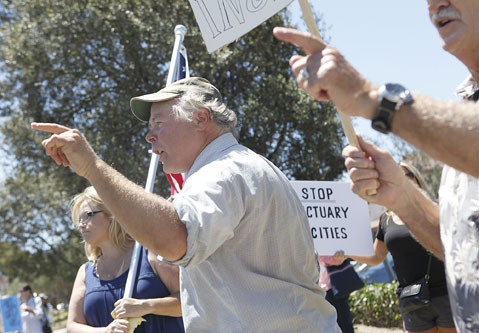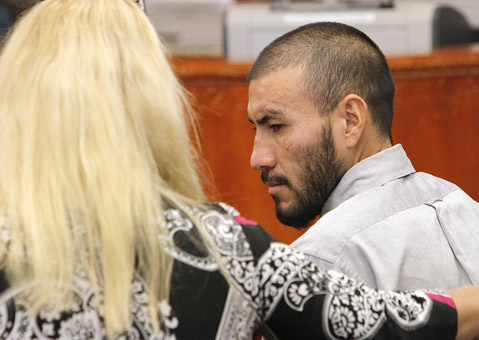Feds and Sheriff Square Off over Murder
Santa Maria Woman’s Murder by Undocumented Immigrant at Finger-Pointing Stage

There’s scant agreement about anything surrounding the murder of Marilyn Pharis, a 64-year-old Vandenberg worker and Santa Maria resident, except for the savage way she was done in. About 10 a.m., July 24, two men broke into Pharis’s Dejoy Street home, raped and strangled her, and then beat her with a hammer. When they were done, both of Pharis’s eye sockets had been shattered and her neck broken. She would not die, however, for another eight days.
One of the two men since arrested and charged with rape, torture, and murder — Victor Martinez — is an undocumented Mexican immigrant. Santa Maria Police Chief Ralph Martin stated Martinez had been arrested in the past 15 months no fewer than six times. Martinez walked out of County Jail most recently just four days before allegedly killing Pharis, a crime for which he has pleaded not guilty.
Given this incendiary trajectory, Martinez has emerged as Santa Barbara County’s poster child for the intensely anti-immigrant jeremiads called forth by presidential candidate Donald Trump. Fox commentator Bill O’Reilly has seized upon Martinez as Exhibit A for everything that’s wrong with President Barack Obama’s immigration policy. This week, no less a personage than crime show host Nancy Grace exhorted viewers to call Santa Barbara District Attorney Joyce Dudley to express their outrage and displeasure. Grace posted the DA’s phone number on the screen.

As the politics surrounding America’s immigration debate grow ever more radioactive, so, too, does the intensity of the argument now escalating over who is most to blame for “letting” a certified repeat offender like Martinez out of jail. Sheriff Bill Brown and Santa Maria Police Chief Martin wasted little time in blaming Proposition 47, passed last November by state voters, which prevents prosecutors from charging low-level drug possession crimes as anything but misdemeanors. The bulk of Martinez’s transgressions involved possession of methamphetamine. If not for Prop. 47, Brown insists, Martinez could have been charged with a felony and held in custody for at least 15 days. Retired judge George Eskin, a vocal supporter of Prop. 47, took heated exception, noting that even before Prop. 47, it was customary for Santa Maria prosecutors to file meth possession merely as a misdemeanor.

More pointedly, Sheriff Brown also questioned why federal authorities with Immigration and Customs Enforcement (ICE) have steadfastly refused to seek the court warrants needed by area law-enforcement agencies to detain defendants like Martinez past their locally mandated time behind bars. Without such warrants, Brown stated, a raft of federal court rulings has made it painfully clear local authorities could be successfully sued for holding undocumented immigrants at ICE’s behest. Under existing law, Brown noted, ICE could still seek advance notice of immigrant prisoners’ release dates. In the case of Martinez, Brown pointed out, no such request had been made. ICE spokesperson Virginia Tice countered that her agency had, in fact, sought advance notice the previous time Martinez had been arrested and jailed — in 2014 — for attempted sexual assault, but that no reply was forthcoming. ICE acknowledged no such request was made this July, explaining, “He had no prior deportations or significant criminal convictions.” In addition, ICE officials have argued that no federal warrant exists that they could see from a federal magistrate to secure the “holds” described by Sheriff Brown.
From there, the picture gets only muddier. One thing, however, is clear. The criminal profile of Martinez appears a far cry from San Francisco’s now infamous Juan Francisco Lopez-Sanchez, the other accused killer now galvanizing supporters of stricter immigration policies. Unlike Lopez-Sanchez, who’d been deported five times before shooting — accidentally, he claimed; randomly, police say — 32-year-old Kathryn Steinle by San Francisco’s picturesque Pier 14.
Martinez was never convicted of a felony prior to the Pharis murder and only accused of a felony once before. Where Lopez-Sanchez had a lengthy criminal history and had been deported five times, Martinez never had been. Martinez’s attempted sexual assault last year — charged by police as a felony — would ultimately result in misdemeanor battery charges filed by the district attorney. A very drunk Martinez reportedly grabbed a woman around the waist after she’d rebuffed a crude sexual proposition. That was last year.

Most recently, on July 17, Martinez was booked into County Jail at the instigation of Santa Maria police, who charged him with possession of meth (a misdemeanor), possession of a double-edged knife (a felony), and of violating the terms and conditions of probation from an earlier charge.
Even so, authorities were sufficiently untroubled by Martinez’s past to let him go three days later after he’d pleaded guilty and agreed to turn himself in on October 31 to serve a 30-day sentence. In hindsight, questions have arisen about whether the full extent of Martinez’s criminal history was known. Did court administrators — notoriously overworked and understaffed — fail to post Martinez’s entire rap sheet with the State Department of Justice on a timely basis? Preliminary indications suggest some booking info was posted eight months after the fact. Would prosecuting attorneys have behaved differently were it not for that delay? Would it have made a difference for Marilyn Pharis? The answer to both remains speculative in the extreme.
What’s certain is the fundamental disconnect between the federal administrators running ICE and California officials — elected and otherwise — running the Attorney General’s office and the 58 county jails. There was trouble almost from the day ICE started the Secure Communities program in 2010, in which federal immigration agents would place detention holds on undocumented immigrants held in county jails, deporting the most violent and dangerous offenders. By the time it became clear that many low-level, nonserious offenders were being deported, as well, it was too late. About half the first 50,000 people deported from California jails via the Secure Communities program were deemed nonviolent. More than 58 percent of those deported from Santa Barbara in year one of the program were deemed by ICE as “nonserious.”
In response to the uproar by civil libertarians and immigrant-rights advocates, California Attorney General Kamala Harris ruled in 2012 that an ICE hold was merely a request, not a binding document. In 2013, two federal judges ruled counties could be held legally liable if they held inmates beyond the terms of their local sentences. In 2013, the California Legislature passed the TRUST Act (Transparency and Responsibility Using State Tools Act), which placed severe restrictions on the ability of county jail administrators to cooperate with ICE in such holds. For Assemblymember Das Williams, who initially opposed the TRUST Act but later supported it — citing safeguards added for cooperation when it came to violent offenders — it proved a painful time as he found himself slammed by some longtime supporters in the immigrant-rights community for his hesitancy. It remains doubtful, however, that even with the insertion of those safeguards whether Martinez — given his low-level criminal history — would have qualified as a serious and dangerous county jail inmate as defined by the TRUST Act.
Nothing anybody does will bring Marilyn Pharis back to life. Sheriff Brown is hoping that Congress might take action requiring that ICE — in seeking to execute a hold on a potentially dangerous inmate — obtain the federal warrants required to meet the due process mandates imposed by the TRUST Act, as well as two federal judges. Brown, to date, has not discussed the matter with Congressemember Lois Capps, who is currently engaged on a fact-finding mission of her own to figure out how to reconcile the starkly conflicting positions put forth by ICE officials and county law enforcement. County Supervisor Steve Lavagnino — who represents Santa Maria — has called for a special meeting on the matter, which is now slated for September 22. And this weekend, opposing camps in the immigration wars are girding for a second showdown in Santa Maria, organizing for yet another round of public demonstrations.
This story was corrected to reflect that Santa Maria’s county supervisor is Steve Lavagnino, not Larry, his father, who was Santa Maria’s mayor from 2002-2012.



